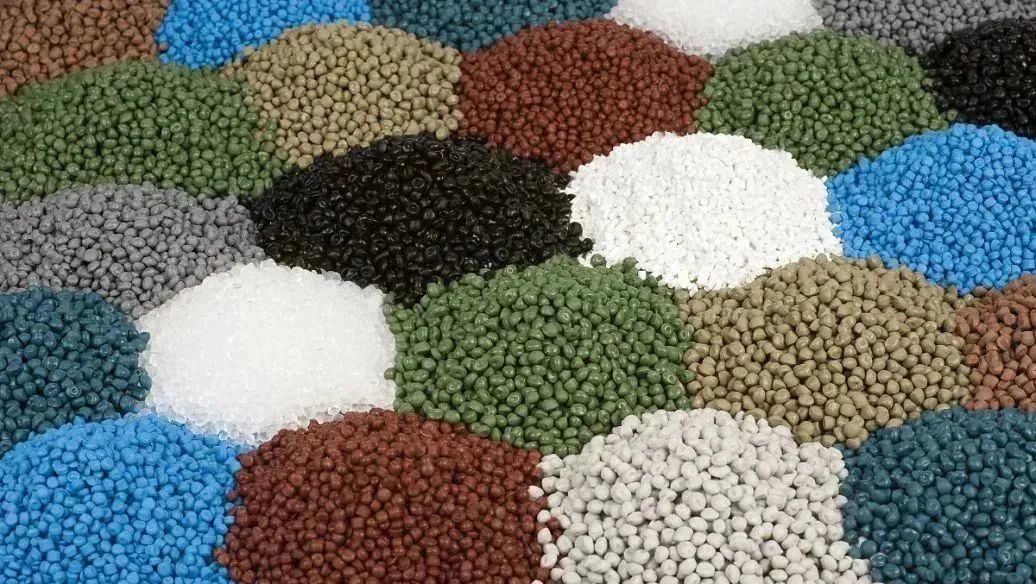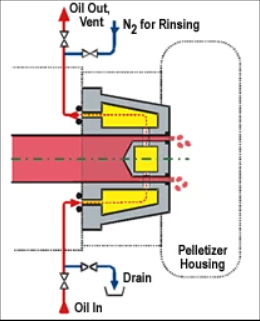Extruders are increasingly using underwater granulation to produce engineering polymers, including resins such as PET, nylon, and polycarbonate. These resins have "difficult" characteristics such as low viscosity and/or rapid cooling or high melt temperature.
Compared with strip granulation, underwater granulation has advantages such as good particle quality, high degree of automation, and low cost. However, compared to less sensitive commodity resins such as polyethylene, polypropylene, or polystyrene, there is a greater risk of mold freezing when producing engineering resins such as those mentioned in the previous paragraph.
Underwater granulators typically use circular die heads with 10 to 20 holes or even hundreds of holes. The system can be designed for compounding anywhere from a few hundred to nearly 20000 pounds per hour. (Even larger pelletizers are used for extrusion production.)

Reasons for mold hole freezing
The diameter of the mold hole is usually 0.125 inches, but for smaller particles, it can be as small as 0.01 inches or as large as 0.20 inches. The output of each hole is approximately 25-100 pounds per hour, but the average output of 0.125 inch mold holes is approximately 30 pounds per hour.
The key to underwater granulation is to transport enough hot plastic through the mold holes, keeping the holes at the melting temperature of the resin, while the melt and mold head come into contact with water at a temperature several degrees lower. Metal molds are a very good thermal conductor, so unless the polymer flow through the mold holes is sufficient, water will cool the holes and the polymer will solidify in them. However, the processor cannot immediately know that this blocking has occurred.
The problem is that if one or more mold holes are blocked by polymer, the efficiency of the mold head will decrease. Ultimately, blocked holes will affect the flow of surrounding holes, resulting in larger and irregularly shaped finished particles and a decrease in production. Ultimately, it is necessary to completely shut down the production line to clean the mold holes.
The main reasons for mold freezing are as follows: polymer and water flow, as well as improper start-up sequence of cutter operation; Insufficient heating and insulation of the mold and process fluctuations. Ignoring the material formula (resin, filler level, and filler type - heat absorption or thermal conductivity) can also lead to problems. But you cannot change the formula to please the pelletizer, it should be designed to run most formulas.
Adjusting the start-up process of the granulator
Most mold hole freezing occurs during startup, during which the resin, cooling water, and cutter must be started in the correct order. If the resin begins to flow through the mold and the tool engages before the water reaches the mold surface, coating and resin blockage will occur outside the holes in the water tank. If water reaches the mold surface before the polymer begins to flow, excessive cooling can cause the holes to freeze.
In early underwater granulation systems, skilled operators manually controlled this sequence. Starting from the early 1990s, automation and control can be achieved through commercial PLC control systems. The polymer diverter valve and process water bypass system enable the PLC to more accurately control the time when polymer and water enter the mold. The pelletizers manufactured since the mid-1990s provide automatic cutting systems that use hydraulic, pneumatic, and servo motors to control cutting pressure. Therefore, today's fully automated system can control the startup sequence in a fraction of a second.
Optimize mold design
Once the production line is started and running, maintaining a very constant flow of material through the mold holes can prevent most molds from freezing. But some freezing issues are related to the mold design itself.
The mold is heated by a flashlight heater or hot oil. Electric heating is not completely uniform because ink cartridges are mainly placed in the ring around the mold hole, near the outer edge of the mold plate. Therefore, the holes around the outside of the tube core are often hotter than the holes in the center. (The mold manufacturer has attempted to add a cylinder to the center of the mold, but engineering has proven to be clumsy.)
Therefore, cylindrical heaters may not be suitable for large molds or materials with a narrow melting temperature range, such as nylon, which may tend to freeze at the center of the mold.

Compared to cylindrical heaters, oil heating can apply more uniform heat on a larger area. The oil system is equipped with up to eight mold areas. But oil heating is more expensive than cylindrical heaters. Oil heating is commonly used in high output production lines of resin manufacturers or large blending plants. Recently, it has been applied on smaller systems to achieve better temperature control.
If the oil valve is blocked, the mold holes in the affected area of the mold will become colder and may freeze, but the rest of the mold will be fine. The initial output may not change. Similarly, like cylindrical heaters, the problem will manifest as defective particles.
All pipe cores have some type of insulation layer. Most molds use special plates attached to the middle of the mold surface. But the plates may come loose. Then water flows behind them, cooling the mold and possibly causing it to freeze.
Another insulation method is to use a "hollow" mold design that includes vacuum gaps. If not part of the original template design, it can be modified to most systems. Vacuum is a good insulator that cannot be damaged like solid insulation boards.
Reduce process fluctuations
Any type of extrusion process interruption or output fluctuation may lead to freezing. For example, extruding recycled materials with low bulk density can cause fluctuations and fluctuations in the output of the extruder, resulting in inconsistent polymer flow and random freezing of the mold holes. Polymer melt pumps can be used to prevent these fluctuations and provide consistent die flow.
The use of discontinuous skateboard type screen changers can also cause flow interruption and interception of air, resulting in temporary loss of polymer flowing to the mold hole. It may cause random freezing of the mold holes. The solution is to use a continuous screen changer, which can immediately replace dirty screens without interrupting the process or intercepting air.
Nanjing Kunwei Lansheng Extrusion Intelligent Equipment Co., LTD
Address: No. 9 Guangtai Road, Dujiangyan City, Chengdu City, Sichuan Province
45 Limao Road, Wujin District, Changzhou City, Jiangsu Province
Tel:400-096-8228
E-mail:sales@njkwls.com
